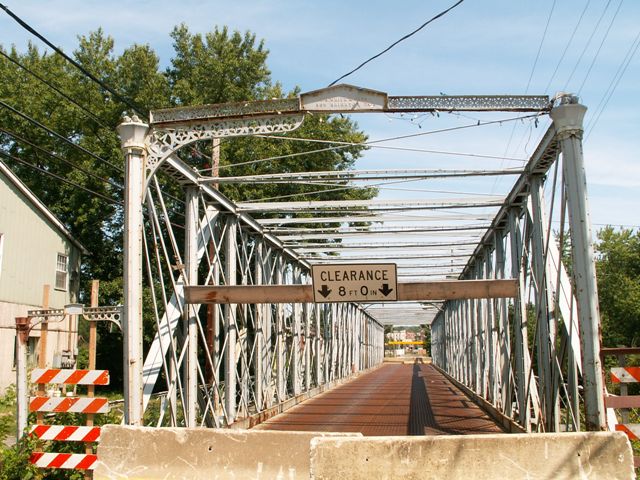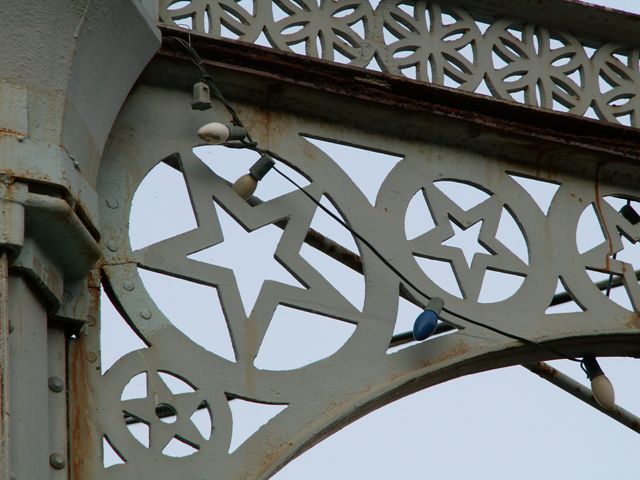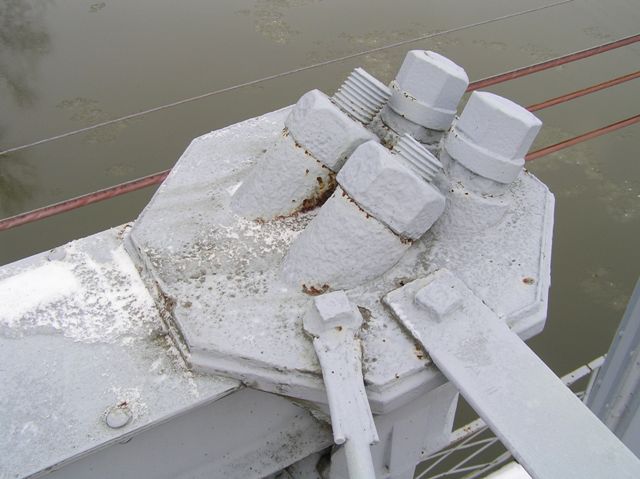We Recommend:
Bach Steel - Experts at historic truss bridge restoration.
BridgeHunter.com Phase 1 is released to the public! - Visit Now
Mead Avenue Bridge

Primary Photographer(s): Nathan Holth and Rick McOmber
Bridge Documented: June 10, 2004, July 1, 2006, and August 4, 2007
Meadville: Crawford County, Pennsylvania: United States
Metal 14 Panel Multiple-Type-Connected Whipple (Double-Intersection Pratt) Through Truss, Fixed
1871 By Builder/Contractor: Penn Bridge Company of Beaver Falls, Pennsylvania
1937
129.0 Feet (39.3 Meters)
268.5 Feet (81.8 Meters)
19.4 Feet (5.91 Meters)
2 Main Span(s)
20730188203000

View Information About HSR Ratings
Bridge Documentation
This bridge is in storage!
Bridge Status: Replaced, but trusses dismantled in 2015 and placed into storage for possible reuse by a private owner.This bridge's song is:
View Archived National Bridge Inventory Report - Has Additional Details and Evaluation
View Historic American Engineering Record (HAER) Documentation For This Bridge
HAER Drawings, PDF - HAER Data Pages, PDF
Read a HistoricBridges.org exploratory proposal for preservation or salvage of all or part of Mead Avenue Bridge.
View the Memorandum of Agreement for this Historic Bridge
Status and Fate of The Bridge
This remarkable bridge is one of Pennsylvania's most unusual and historically significant bridges, and is in fact a nationally significant bridge that is today threatened with demolition. The bridge has faithfully served traffic since its completion in 1872, and is a testimony to the efforts of both the designers and builders of the bridge, as well as the craftsmen who fabricated the various parts of the bridge. However, 135 years later in 2007 the bridge was closed to traffic. As of 2014, the plan is to demolish and replace this unique historic bridge! Although Pennsylvania has an unrivaled number of rare, historic truss bridges, it also has an extremely low number of preserved historic truss bridges, and the number of surviving structures is rapidly decreasing as historic bridges continue to be demolished. Among these numerous, rare bridges of Pennsylvania, this bridge stands out as a bridge that can truly be called unique, beautiful, and tremendously significant.
The bridge does suffer from significant deterioration, particularly in the lower portions of the bridge where salt and moisture have combined with a lack of good maintenance to do their damage. Worse, many of the repairs that were done to the bridge over the years were somewhat crude in design, and likely made the problem worse in the long term since they were more of a bandage than a full restoration. An experienced welder examined the bridge and commented, only somewhat jokingly, that the only apparent required skill for workers that made some of the welded repairs was that the worker knew how to turn the welder on!
Despite these problems, the bridge could and should be restored, at least for non-motorized use, perhaps relocated to a new location. Restoration would likely require the replication of several parts of the bridge deteriorated beyond repair. However, a significant amount of original bridge material would remain as well. It is worth noting that the Commonwealth of Pennsylvania is stuffed full of preserved historic wooden covered bridges. Many of these bridges were rehabilitated in a manner that very little original bridge material remains, with the majority of the bridge replicating the original materials using new material. Pennsylvania does not bat an eye toward such a preservation project for wooden covered bridges. Why, then, is the same not true for a historic metal truss bridge that is just as old and even more rare than any covered bridge? The reality is that even with the amount of replication and restoration that the Mead Avenue Bridge needs, the bridge would likely have much more original material than the average preserved wooden covered bridge. In a state whose heritage lies in the iron and steel industry, this bias toward preserving wooden covered bridges is unfair, unwise, and shortsighted.
It is paramount that the plans for demolition of this bridge be halted immediately, and that this bridge be preserved. A restoration project could rehabilitate the bridge for light vehicular use, or the bridge could bypassed by a modern bridge and the historic bridge restored for pedestrian use. The bridge could also be relocated and preserved in a new location. Whatever solution might be selected, the key is that this historic bridge, along with its rare Keystone Columns continues to be a landmark attraction. Its loss would mark a tragedy that would be felt for generations to come.
About The Bridge
The Mead Avenue Bridge in its current condition is unique for many reasons. As it stands, it is essentially two bridges in one. The original bridge was built from 1871-1872. In 1912, Baltimore trusses were added to the bridge, with the intention of being emergency repairs to increase the weight limit of the bridge for ten years. Instead, they proved sufficient to produce essentially continuous service for 95 years! Additional substantial work was done on the bridge in 1937. The original part of the bridge is an extremely old 1871 truss structure, and is a rear two-span example of the Whipple truss configuration. However, perhaps the most important element of significance is that the bridge (the Whipple truss portion) uses rare Keystone columns for vertical members and end posts. Keystone Columns are an extremely rare form of built-up member. Few bridges today have Keystone Columns, being far less common than the also rare patented Phoenix Column. The Whipple truss bridge was built by the Penn Bridge Works of Beaver Falls, Pennsylvania. Union Iron Mills (an early venture of Andrew Carnegie) was where the iron originated from, according to marks on the bridge. Bridges with Keystone columns were often associated with Andre Carnegie's Keystone Bridge Company, but the columns were made available to anyone who wanted them... in this case the Penn Bridge Works.
The portal bracing on the Mead Avenue Bridge has been through a lot, and is damaged and or missing in many places, particularly at the western end. However, most of this decorative bracing is intact at the eastern end of the bridge. Because of this, the intact portal bracing could be used as a guide to replicate portal castings for the western end of the bridge. The design of the portal bracing, featuring a complex assembly of star-shaped objects is very ornate and complex, and greatly adds to the beauty of the bridge, forming a structure that is truly a work of art. Perhaps the most innovative compliment to this portal bracing in the form of decorative archways at the end of the sidewalks that even feature 1871 plaques overhead and their own unique portal design made up of a pattern of circles. These cantilevered sidewalks also feature an unusual design of lattice railing, which only further adds to the interest and appearance of the bridge. The attention to detail and appearance on this bridge is a perfect example of what sets a historic truss bridge apart from modern bridges of the 21st century.
The trusses that were added to the bridge date to 1912 and feature a Baltimore truss configuration and have riveted connections. It was built by Rodgers Brothers Company of Albion, Pennsylvania. Combined, these trusses convey an unusually strong sense of passing through a tunnel, which makes this bridge a fun experience to cross.
This bridge is tagged with the following special condition(s): Keystone Columns
![]()
Photo Galleries and Videos: Mead Avenue Bridge
Structure Overview
Original / Full Size PhotosA collection of overview photos that show the bridge as a whole and general areas of the bridge. This gallery offers photos in the highest available resolution and file size in a touch-friendly popup viewer.
Alternatively, Browse Without Using Viewer
![]()
Structure General Details
Original / Full Size PhotosA collection of detail photos that document the parts, construction, and condition of the bridge. This gallery offers photos in the highest available resolution and file size in a touch-friendly popup viewer.
Alternatively, Browse Without Using Viewer
![]()
Truss Connection Details
Original / Full Size PhotosA collection of detail photos that document the parts, construction, and condition of the truss connections on the bridge. This gallery offers photos in the highest available resolution and file size in a touch-friendly popup viewer.
Alternatively, Browse Without Using Viewer
![]()
Structure Overview
Mobile Optimized PhotosA collection of overview photos that show the bridge as a whole and general areas of the bridge. This gallery features data-friendly, fast-loading photos in a touch-friendly popup viewer.
Alternatively, Browse Without Using Viewer
![]()
Structure General Details
Mobile Optimized PhotosA collection of detail photos that document the parts, construction, and condition of the bridge. This gallery features data-friendly, fast-loading photos in a touch-friendly popup viewer.
Alternatively, Browse Without Using Viewer
![]()
Truss Connection Details
Mobile Optimized PhotosA collection of detail photos that document the parts, construction, and condition of the truss connections on the bridge. This gallery features data-friendly, fast-loading photos in a touch-friendly popup viewer.
Alternatively, Browse Without Using Viewer
![]()
Maps and Links: Mead Avenue Bridge
Coordinates (Latitude, Longitude):
Search For Additional Bridge Listings:
Bridgehunter.com: View listed bridges within 0.5 miles (0.8 kilometers) of this bridge.
Bridgehunter.com: View listed bridges within 10 miles (16 kilometers) of this bridge.
Additional Maps:
Google Streetview (If Available)
GeoHack (Additional Links and Coordinates)
Apple Maps (Via DuckDuckGo Search)
Apple Maps (Apple devices only)
Android: Open Location In Your Map or GPS App
Flickr Gallery (Find Nearby Photos)
Wikimedia Commons (Find Nearby Photos)
Directions Via Sygic For Android
Directions Via Sygic For iOS and Android Dolphin Browser
USGS National Map (United States Only)
Historical USGS Topo Maps (United States Only)
Historic Aerials (United States Only)
CalTopo Maps (United States Only)




